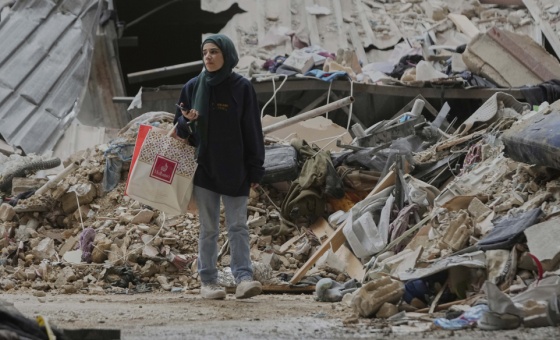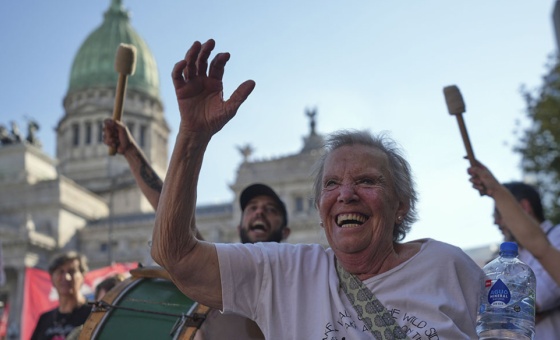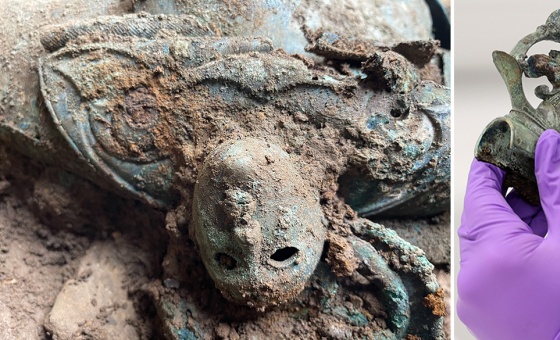This is the last article you can read this month
You can read more article this month
You can read more articles this month
Sorry your limit is up for this month
Reset on:
Please help support the Morning Star by subscribing here
ARRIVING in Kyrgyzstan’s capital Bishkek, it is impossible not to immediately fall in love with this city of almost a million people. It’s profoundly green, and as I’m to be told by at least five people over the next few days, this is something residents are proud of. “Frunze was once the greenest city in the Soviet Union,” they all tell me as if they have been rehearsing the same script.
Within the first hour, I have found a statue of Karl Marx and Friedrich Engels, the Memorial to the Great Patriotic War, and a powerful statue of Vladimir Lenin himself. I am astounded at how Soviet it all feels, as if I’ve been brought back in time to the 1980s.
What isn’t Soviet is the name of the city. Renamed from Piskpek to Frunze in 1926 to honour Bolshevik military strategist and army officer Mikhail Frunze, it was renamed Bishkek in 1991 as the Soviet Union was being dissolved.
Considering the swift name change at that time, it is remarkable that so much of the Soviet heritage has survived, including the names of the city’s neighbourhoods: October, Lenin, First of May, and Sverdlov (for Yakov Sverdlov, considered the first head of state of the USSR).
Although Frunze has been stripped of its name, he still has an incredible museum named after him in the heart of the city. I am greeted enthusiastically at the entrance to the Frunze Museum by an ethnically Russian guide, himself named Mikhail, who happens to originally be from Kazakhstan.
The Russian population of Bishkek is at least 15 per cent, down from being the majority during the Soviet period. Despite that, the Russian language is more commonly heard on the streets than Kyrgyz, still being the lingua franca.
Mikhail leads a remarkably enthusiastic tour through the museum, going over everything from Frunze’s upbringing in what was then Piskpek, to the struggle of the Red Army during the Russian civil war against the White Army and the imperial powers. His tour seems like it is straight out of Soviet textbooks. As I am to find out, people here are generally extremely proud of their Soviet heritage.
Sitting at the city’s main Ala-Too Square is the State History Museum. There’s a lot about the origins of the Kyrgyz people to be learned here, but by far the largest part of the exhibition deals with the establishment of the Kyrgyz Soviet Socialist Republic. One of the information boards makes it clear: “The October revolution created the prerequisites for reviving statehood for the Kyrgyz people.”
That alone might help to understand why, despite more than three decades of independence and the restoration of capitalism, the Kyrgyz authorities and people still feel indebted to the history of the Bolshevik revolution and their historic friendship with Russia. It is no wonder that Lenin’s towering statue continues to greet visitors at the rear of the museum.
When Kyrgyzstan became independent in late 1991, there was continuity in its leadership, with former Communist Party leader Askar Akayev retaining power. He would hold the office of president for 15 years.
Although Akayev would go on to sell off much of the publicly owned property of the people, it was also clear by the mid-2000s that he had not gone far enough for the only superpower at the time. The United States backed the “tulip revolution” of 2005 and very warmly looked forward to a post-Akayev period, as he fled into exile in Moscow.
Another colour revolution, referred to as the melon revolution, occurred in 2010 just five years after Akayev’s ouster and brought the presidency of Kurmanbek Bakiyev to an end. Renewed protests in 2020 brought the formerly jailed Sadyr Japarov to power.
On my second day in Bishkek, I meet Talgat, a tour guide in his early fifties. He’s a character, to say the least. His perfect English and slight American accent gives away that he has lived abroad for a while, in sunny Florida. It is not the US, however, but the USSR, that he feels nostalgia for.
“Growing up, we practically saw the entire USSR. We had family trips to Armenia, to Turkmenistan, to Moscow. My parents had plenty of time off work, and these trips barely cost us anything.
“When our family would get bigger each time another sibling was born, we would become eligible for a new apartment. We basically had no anxiety about life.”
Talgat remembers his time in the Young Pioneers, the youth league of the Communist Party, and the concept of “friendship of peoples” (druzhba narodov) between different nationalities that was ingrained in him. He was nearly finished with his university studies when the collapse of the USSR changed everything.
“The 1990s was basically the Wild West. It was insane. Everyone had a gun and everyone was trying to get whatever they could. The city started to crumble. Nobody took care of it anywhere.”
His sentiments are echoed in a 2009 Gallup poll that found that 62 per cent of respondents felt as if the dissolution of the Soviet Union harmed Kyrgyzstan, while only 12 per cent believed it brought significant benefits to the country.
Although conceding that President Japarov isn’t about to bring socialism back to his homeland, he views his period in office so far as positive.
“It seems like some good things are happening. What I mean is that the corruption this country has known, the greedy elites, are finally being dealt with.”
My tour guide’s positive take on Japarov gets echoed in many conversations I have around Bishkek that cut across generational divides. The major reason I hear for people approving of the job Japarov has been doing deals with what seems like a matter of national pride: the kicking out of the country of the Canadian company Centerra Gold and the renationalisation of the Kotor mine in 2021.
Talgat doesn’t mince his words about Centerra. “Those bandits destroyed our country. They should never have been allowed in to begin with. That was all Akayev’s doing when he thought selling off the resources would make us richer. It was all a lie.”
Centerra, which had set up shop in the country in 1994 at the high-altitude mine, was charged with environmental degradation that ultimately cost the Kyrgyz state $3 billion after they dumped waste on glaciers that led to their erosion.
Japarov didn’t just move to make sure the mine was taken into state ownership but also punished several Kyrgyz political figures who had got rich from the Centerra deal.
Japarov’s populist persona has effectively been shaped by this struggle against foreign banditry with the help of local collaborators. He was serving an 11-year sentence for kidnapping a local political figure linked to the Kumtor mine before being freed and taking over the presidency.
All that being said, Japarov himself has said he is not necessarily opposed to foreign investment. His Mekenchil, or Patriotic Party, is largely shaped by populism, and can be broadly classified as national conservative.
One of Japarov’s supporters is Aza, who was born in an independent Kyrgyzstan and has just turned 23. Given that he’s in many ways a representative of a new generation, I wonder if he feels optimism for his future.
Just like the other four post-Soviet Central Asian states, Kyrgyzstan has been strengthening its relationship with China.
Aza tells me that he just spent two years living in China, something he decided to do because he sees the evolving Kyrgyz-China relationship as key to the future. He’s set up a mail-order clothing business between the two countries and says he’s prioritised becoming fluent in Mandarin.
Kyrgyzstan says that it is walking the fine line of what it calls a “balanced” foreign policy that aims for good relations with the big powers of Russia, China and the US. It is evident, however, that with US influence on the decline globally, it is really Moscow and Beijing that are the priority for the government in Bishkek.
The question remains whether the multipolar world will usher in significant improvements for the workers of the Kyrgyz Republic, as those two things are by no means guaranteed to be linked.
Returning to Talgar, he makes a very straightforward observation. “If we can get rid of the Canadian robbers, the American robbers, all of those robbers, I would be very happy. At least then we can say we are a meaningfully independent country. To me, that’s important.”
Marcel Cartier is a hip-hop artist, author and journalist. His video series on the former Soviet Union will be released this autumn.










